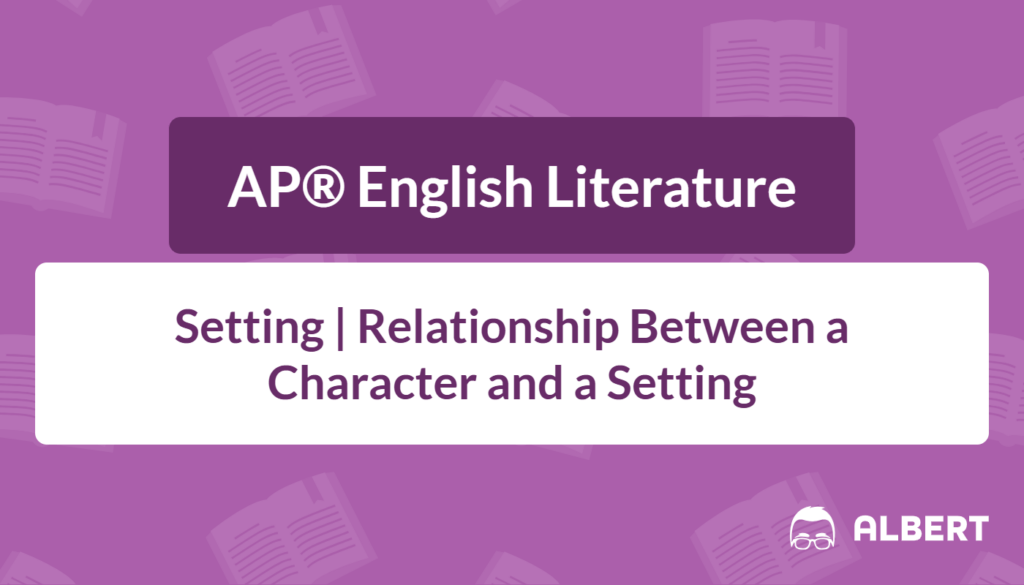What We Review
Exploring the Power of Character and Setting
Characters and settings often work together to form the heart of a story. When a character steps into a particular location—whether it is a grand castle or a small Midwestern town—their traits and motivations can shift in subtle ways. At the same time, physical places can reflect and even change a character’s outlook. Seeing how these two elements interact is important for strong literary analysis, especially on the AP® Literature exam. This post will clarify the concepts of character and setting, then show how to analyze their relationship step by step. By the end, the connection between character, setting, and plot should feel more approachable.
Defining Character and Setting
What Is a Character?
A character is any individual who takes part in a literary work. Characters are not always human; they can be animals, deities, or even machines with person-like qualities. However, most stories center on protagonists (main characters) working toward a goal and antagonists (characters in conflict with the protagonist). Minor characters can also shape the conflict, adding complexity to the plot.
In Jane Eyre by Charlotte Brontë, Jane’s experiences and growth shape the narrative’s direction. Jane is the protagonist, whose inner strength and moral resolve guide her through hardship. The setting of Thornfield Hall—a remote, mysterious estate—mirrors the secretive and turbulent emotional landscape Jane must navigate. From this example, it becomes clear that a character’s ambitions and struggles influence how readers interpret a place.
What Is a Setting?
Setting includes factors such as time period, geographical location, weather, and social conditions. It shapes how characters behave and can also serve as a foil to highlight traits. In the same novel, Thornfield Hall is not just a backdrop but a symbol of isolation, secrets, and danger. Its gloomy rooms and hidden corridors reflect Jane’s feelings of confinement and anticipation. Brontë uses descriptions like “dark corridors” and “chilly hallways” to emphasize the eerie mood.
In short fiction or plays, setting might be a single, pivotal location. A small town or a family home can become a microcosm of bigger societal tensions. By narrowing the physical space, stories often create intense emotional moments. When characters are limited to one farmstead, one plantation, or one household, tiny details of the setting matter more. This attention to specificity transforms the place into a powerful tool that shapes the protagonist’s journey.
How Character and Setting Influence Each Other
The Character’s Impact on the Setting
Sometimes a character’s inner world reshapes how the environment is understood. In Heart of Darkness by Joseph Conrad, Marlow’s psychological state colors every part of his journey down the Congo River. The oppressive jungle feels like a reflection of the darkness within human nature and Marlow’s own moral conflicts. For instance, Conrad’s descriptions of “the brooding gloom” and “mysterious wilderness” suggest that Marlow’s existential doubts transform the landscape into something symbolic and foreboding.
From this example, it is helpful to notice how:
- A character’s emotions can alter the perception of a place.
- Descriptive words echo the character’s mindset.
- Readers see the setting through the character’s subjective lens.
The Setting’s Influence on the Character
Conversely, certain settings can drive characters to reveal traits they never showed before. In The Scarlet Letter by Nathaniel Hawthorne, the strict Puritan settlement shapes Hester Prynne’s identity and resilience. The oppressive town environment, with its rigid moral code and public shaming, forces Hester to develop strength and independence. Hawthorne writes about the “ironclad” judgment of the community, illustrating how social setting pressures and challenges her.
When analyzing moments like these, it can be useful to:
- Observe the physical dangers or limitations the setting introduces.
- Examine whether the character succeeds, adapts, or fails in response.
- Ask how those changes link to the larger message or theme.
Analyzing the Relationship Between Character and Setting
Key Questions to Consider
- How does the character interact with the environment?
- Which features of the setting appear most significant to the character?
- How do social, cultural, or historical elements of the setting reveal or challenge the character’s beliefs?
- Does the setting mirror or contradict the character’s personality or goals?
Step-by-Step Example of Analysis
For a closer look, consider Wuthering Heights by Emily Brontë. The wild, untamed moors surrounding the Earnshaw home create a raw and volatile atmosphere that mirrors Heathcliff’s passionate and vengeful nature.
- Choose a Character
- Look at Heathcliff, a brooding figure shaped by love, loss, and bitterness.
- Identify Character Traits
- Heathcliff is intense, passionate, and often cruel, driven by a desire for revenge and belonging.
- Observe the Setting
- The moors are described as “bleak” and “wild,” with the open, stormy landscape reflecting emotional turbulence and freedom from societal norms.
- Connect Character Motivations with the Setting
- The moors’ harshness and isolation reflect Heathcliff’s inner turmoil and alienation. The environment’s raw beauty and danger symbolize the extremes of his emotions and actions. The wild setting pushes Heathcliff to act outside social conventions, driving key conflicts and character development.
Through these steps, it becomes clear that the physical and symbolic aspects of the moors are inseparable from Heathcliff’s complex personality and the novel’s themes.
Real-World Relevance of Character and Setting
Character and setting do not exist only in fiction. Real-world environments often shape personal decisions in unexpected ways. People tend to speak and act differently in a crowded city than in a quiet countryside. In literature, these shifts become essential to the plot and theme.
Toni Morrison’s Beloved exemplifies how a home’s haunted atmosphere reflects a character’s trauma. Sethe’s house at 124 Bluestone Road vibrates with pain from the past, which eventually forces her to face her own history of enslavement. This home, with its mysterious presence, reveals Sethe’s struggle to find emotional freedom. Realistically, certain memories and histories can cling to a place, reminding readers that physical environments often tell hidden stories about the characters who occupy them.

Short fiction uses this dynamic too. In brief narratives, a single setting can become a focal point that changes a character dramatically by the final paragraph. Whether the setting is a dimly lit street or a sun-soaked beach, the atmosphere can trigger reflection, conflict, or resolution. This close relationship between character and setting often shapes the short fiction genre, as it highlights the tension or harmony between who someone is and where they are.
Quick Reference Vocabulary Chart
Below is a concise chart of key terms related to character and setting, along with short definitions:
| Term | Definition |
| Protagonist | Main character who drives the plot forward |
| Antagonist | Character or force that opposes the protagonist |
| Dynamic Character | A character who undergoes significant change in personality or perspective |
| Static Character | A character who remains relatively unchanged throughout the story |
| Setting | The time, place, and social context of a story |
| Atmosphere | The emotional tone or mood created by the setting |
| Social Context | The cultural, societal, or historical environment impacting the characters’ beliefs and actions |
| Foil | A character or element that contrasts with another, highlighting specific traits |
| Symbolic Setting | A place that stands for an abstract idea or concept |
| Microcosm | A small-scale setting that mirrors wider societal or universal themes |
Conclusion
A story’s setting does more than provide background; it reveals deep layers of emotion, conflict, and meaning within the plot. When characters move through a setting—whether it’s the mysterious Thornfield Hall in Jane Eyre, the oppressive jungle in Heart of Darkness, or the harsh Puritan town in The Scarlet Letter—they often face moments that shape who they become. At the same time, their experiences bring out qualities of the environment itself, creating a dynamic interaction between character, setting, and plot. Recognizing these connections sharpens literary analysis and builds confidence when writing essays for the AP® Literature exam. By asking focused questions and citing specific textual evidence, it becomes easier to show how character and setting work together to deepen a narrative’s themes and impact.
Sharpen Your Skills for AP® English Literature and Composition
Are you preparing for the AP® English Literature and Composition test? We’ve got you covered! Try our review articles designed to help you confidently tackle real-world AP® English Literature and Composition problems. You’ll find everything you need to succeed, from quick tips to detailed strategies. Start exploring now!
Need help preparing for your AP® English Literature and Composition exam?
Albert has hundreds of AP® English Literature and Composition practice questions, free response, and full-length practice tests to try out.








